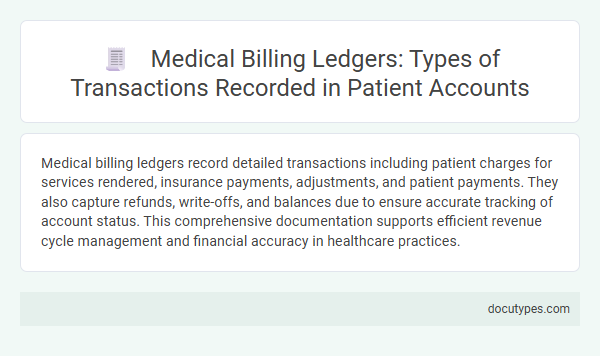Medical billing ledgers record detailed transactions including patient charges for services rendered, insurance payments, adjustments, and patient payments. They also capture refunds, write-offs, and balances due to ensure accurate tracking of account status. This comprehensive documentation supports efficient revenue cycle management and financial accuracy in healthcare practices.
Introduction to Medical Billing Ledgers
Medical billing ledgers play a crucial role in managing financial transactions within healthcare practices. These ledgers provide a detailed record of all billing activities, ensuring accuracy and transparency in patient accounts.
You will find that medical billing ledgers record various types of transactions, including charges for medical services, payments from patients or insurance companies, and adjustments such as refunds or write-offs. Each entry helps track the flow of revenue and identifies outstanding balances. Maintaining accurate ledgers supports efficient revenue cycle management and compliance with healthcare regulations.
Overview of Patient Account Transactions
Medical billing ledgers systematically document various types of patient account transactions to ensure accurate financial records. Understanding these transactions helps you track charges, payments, and adjustments related to healthcare services.
- Charges - Detailed entries of services rendered and their associated costs are recorded.
- Payments - Payments made by patients or insurance providers are documented to update the account balance.
- Adjustments - Corrections, write-offs, and contractual allowances are noted to reflect accurate billing amounts.
These transactions provide a comprehensive overview of your medical billing account activities.
Charges: Recording Medical Services and Procedures
Medical billing ledgers systematically record charges related to medical services and procedures rendered to patients. Each entry details the specific treatments, consultations, or diagnostic tests performed, ensuring accurate billing and financial tracking.
These charges encompass provider fees, surgical costs, laboratory tests, and imaging services. Precise recording of these transactions facilitates claim submissions to insurance companies and supports revenue cycle management in healthcare facilities.
Payments: Capturing Patient and Insurance Payments
Medical billing ledgers record various transaction types, with payments being a critical category. Payments include capturing patient out-of-pocket expenses and insurance reimbursements for covered services. Accurate documentation of your payments ensures proper account management and transparency in healthcare billing.
Adjustments: Handling Discounts, Write-offs, and Corrections
Medical billing ledgers track various transactions including patient payments, insurance reimbursements, and outstanding balances. Among these, adjustments play a crucial role in reflecting accurate account statuses.
Adjustments include handling discounts offered to patients, write-offs due to uncollectible amounts, and corrections for billing errors. Your medical billing ledger ensures transparency by recording these changes precisely to maintain financial accuracy.
Refunds and Overpayments in Patient Ledgers
What types of transactions are recorded in medical billing ledgers? Medical billing ledgers document essential financial activities including charges, payments, adjustments, refunds, and overpayments. Refunds and overpayments in patient ledgers ensure accurate account balances by correcting excess payments and issuing necessary reimbursements.
Managing Co-payments, Deductibles, and Coinsurance
| Transaction Type | Description | Role in Medical Billing Ledger |
|---|---|---|
| Co-payments | Fixed amounts paid by patients at the time of service, as required by their health insurance plans. | Recorded as patient payments; help track out-of-pocket expenses and ensure accurate account balances. |
| Deductibles | The amount patients must pay for covered medical services before insurance begins to pay. | Tracked to monitor how much of the deductible has been met, influencing insurance payment responsibilities. |
| Coinsurance | A percentage of costs patients pay after the deductible is met, sharing expenses with insurance providers. | Logged as part of patient payment obligations; ensures correct calculation of remaining balances and insurance contributions. |
| Insurance Payments | Payments made by insurance companies after deductibles and coinsurance are accounted for. | Recorded to reconcile insurance claims and patient billing ledgers. |
| Adjustments and Write-Offs | Modifications to billed amounts based on insurance agreements or account corrections. | Included to maintain accurate financial records and reflect true patient responsibility. |
| Patient Payments | Payments made directly by patients toward co-payments, deductibles, and coinsurance. | Logged to update account balances and track ongoing patient financial responsibility. |
| Refunds and Credits | Returned funds when overpayments occur or billing errors are corrected. | Documented to ensure proper reconciliation and transparency in medical billing records. |
Managing your co-payments, deductibles, and coinsurance effectively requires precise tracking of these transaction types within medical billing ledgers. Accurate recording safeguards billing transparency and supports clear communication between healthcare providers, insurance companies, and patients.
Recording Insurance Denials and Appeals
Medical billing ledgers meticulously record various financial transactions, including charges, payments, adjustments, and outstanding balances. Insurance denials and appeals are critical entries, documenting rejected claims and the subsequent efforts to contest them for reimbursement. You can track the status and outcomes of these appeals, ensuring accurate financial management and timely resolution.
Tracking Patient Account Balances and Statements
Medical billing ledgers record various types of transactions to ensure accurate tracking of patient account balances and statements. These transactions help maintain transparency and provide clear financial records for healthcare providers and patients.
- Charges - Detailed entries of services rendered and their respective costs posted to the patient's account.
- Payments - Records of payments made by patients, insurance companies, or other third parties applied to outstanding balances.
- Adjustments - Modifications such as write-offs, discounts, or insurance corrections that update the patient's financial obligations.
What Types of Transactions Are Recorded in Medical Billing Ledgers? Infographic

